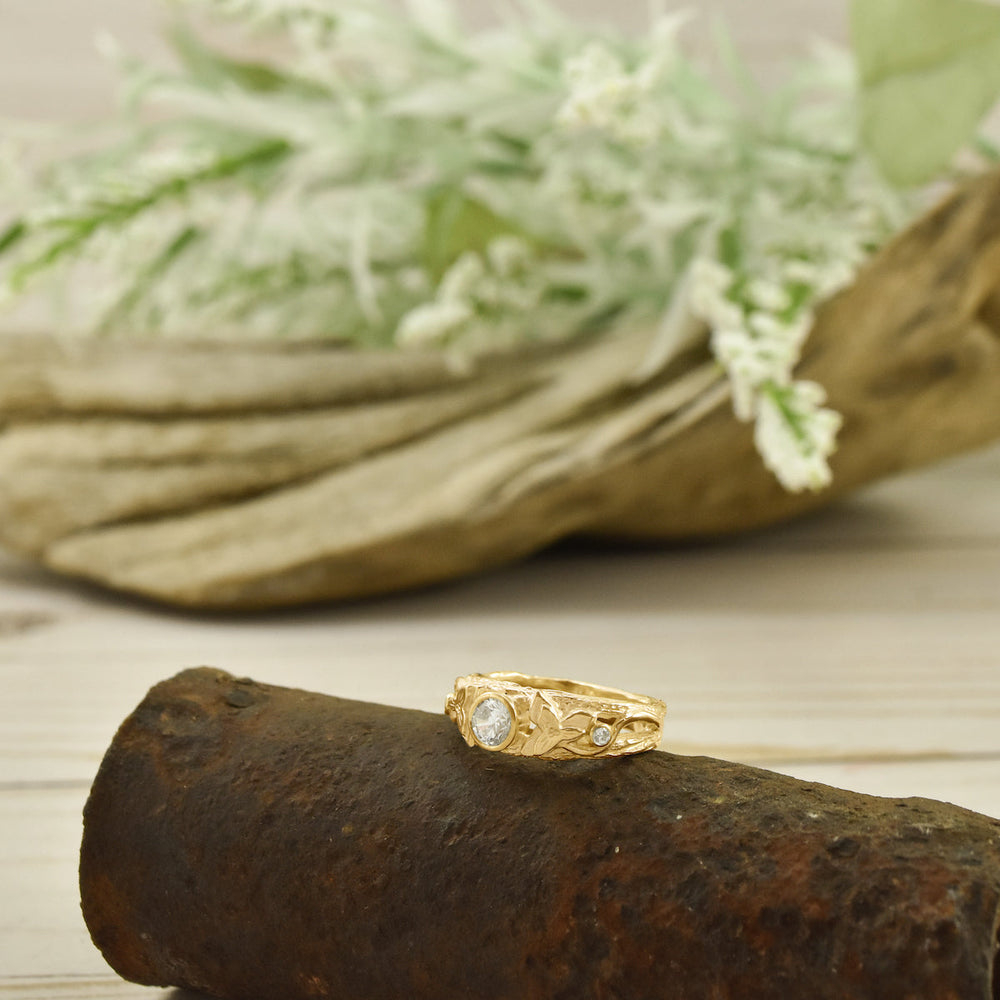
We want your love for nature to be reflected in the jewelry you wear, so we're always looking for ways to make our unique jewelry more sustainable and use materials from ethical sources. We researched the best suppliers for recycled, eco-friendly, and conflict-free diamonds, as well as alternative stones that are just as visually stunning. Read more about each stone below to decide which one fits your dream ring.
Recycled Diamond

Recycled diamonds are stones that already exist in the supply chain that are restored to ensure that they are the same quality as a brand new diamond. Because they bypass the mining process, they are a particularly eco-friendly option.
Conflict-free Diamond

Our conflict free diamonds are recently mined stones. To ensure that they are ethically sourced, our diamond supplier follows the guidelines of the Kimberley process, is in compliance with the United Nations resolutions, and guarantees that the diamonds are conflict free.
Lab-grown Diamond

Lab grown diamonds are real diamonds that were grown under specific conditions in a lab. They are generally excellent in quality, but are much more affordable than mined stones. That said, it is important to note that they will not appreciate value over time in the same way that mined stones will.
Diamonds are the hardest gemstone, and are ranked at a 10 on the Mohs hardness scale. This makes them perfect for everyday wear.
Moissanite
Moissanite might look like diamond, but it is a completely different gemstone! Originally found in meteors, the natural supply is extremely limited, and almost all moissanite on the market is lab grown. Like lab grown diamonds, moissanite will not appreciate value over time. That said, moissanite is more affordable than diamond options, and has more fire (the rapidly changing flashes of color seen in some gems) than diamond. They are a 9.5 on the Mohs scale, and are suitable for everyday wear.
Sapphire

Our Sapphires are mined right here in the United States in Montana. Our supplier is a Gold Level Green America Certified Business, which is an independent certification given to businesses that are environmentally responsible and socially equitable, among other attributes. Each sapphire is heat treated following industry standards to bring out the best color possible from each stone, making them a great option if you’re looking for something blue. They are a 9 on the Mohs scale, and are suitable for everyday wear.
Birthstones
January: Garnet

Garnet is its own mineral class, and comes in a variety of colors, although red is the most common. Garnet is the name that is colloquially used, although most commercial red garnets found in jewelry are specifically Red Almandine. Our garnet is specifically sourced from Idaho. It is a 6.5-8.5 on the Mohs Hardness Scale, which makes it reasonably suitable for everyday wear, although it cannot be resized.
February: Amethyst

Amethyst is a quartz variety stone, and can be heated (either naturally or commercially) to produce citrine and prasiolite (green amethyst). The amethyst that we use in our jewelry is not from the Upper Peninsula, but there are amethyst deposits in the Keweenaw. It is a 7 on the Mohs Hardness scale, which makes it reasonably suitable for everyday wear, although it cannot be resized. Amethyst can fade drastically over time with prolonged sun exposure, so it is important to store them away from sunlight.
March: Aquamarine
Aquamarine is a blue gemstone in the beryl family. Other beryls include emerald and morganite. The name comes from the Italian word for seawater, and it is frequently heat treated to enhance the blue color and remove traces of green. It is a 7.5-8 on the Mohs Hardness Scale, which makes it reasonably suitable for everyday wear, although it cannot be resized.
April: Diamond
Diamond is a mineral composed of pure carbon. It is the hardest naturally occurring substance on earth, and is a 10 on the Mohs Hardness Scale. It is the most suitable stone for everyday wear, and can be resized.
May: Emerald
Emerald is a green gemstone in the beryl family. Other beryls include aquamarine and morganite. Our emeralds are lab grown, which can have advantages over mined emeralds. Mined emeralds are usually highly included, to the extent that inclusions are expected even in high quality stones. Inclusions are any material that is trapped inside of another mineral while that mineral forms. Lab grown stones tend to be more durable because they contain fewer inclusions/fractures. It is a 7.5-8 on the Mohs Hardness Scale, which makes it reasonably suitable for everyday wear, although it cannot be resized.
June: Alexandrite

Alexandrite is a gem-quality variety of chrysoberyl. It is known for displaying color changes in different lights, and is often referred to as “emerald by day, ruby by night”. In its natural form it is both extremely rare and very expensive, and so we source lab grown stones. Although much less expensive than mined stones, lab grown alexandrite is one of the most expensive synthetic gemstones available. It is an 8.5 on the Mohs hardness scale, making it reasonably suitable for everyday wear, although it cannot be resized.
July: Ruby

Ruby is a type of corundum, or sapphire. Sapphire encompasses all colors of corundum except for ruby, which is classified as its own gemstone because of its rarity and historical significance. The color comes from small inclusions of chromium in the stone, which can also make some stones fluorescent. Because it is both rare and expensive, we source lab grown stones. It is a 9 on the Mohs Hardness Scale, making it suitable for everyday wear, and can be resized.
August: Peridot

Peridot is a gem-quality variety of the common mineral olivine. Although olivine can be found in the Upper Peninsula, peridot cannot. We specifically source Mesa Verde peridot, which comes from Peridot Mesa, a mountain on the San Carlos Reservation in Arizona. Mining in this area is restricted to local Apache tribe members. It is a 6.5-7 on the Mohs hardness scale, making it reasonably suitable for everyday wear, although it cannot be resized.
September: Sapphire

Sapphire is a type of corundum, and encompasses all colors except for ruby, which is classified as its own gemstone. We specifically source Montana sapphires. These stones come in a wide range of colors, although most commonly they are a teal blue, and are generally heat treated to increase their vibrance. It is a 9 on the Mohs Hardness Scale, making it suitable for everyday wear, and can be resized.
October: Pink Tourmaline

Tourmaline is a crystalline silicate mineral that can be found in any color, but specifically pink tourmaline is the birthstone for October. Our tourmaline is from California, which is one of the worlds largest producers of gem-quality tourmaline, and is known for bright pink stones. It is a 7 to 7.5 on the Mohs Hardness Scale, making it reasonably suitable for everyday wear, although it cannot be resized.
November: Citrine

Citrine is a quartz variety stone, and occurs when amethyst is heated either naturally or commercially. We specifically source Madeira citrine, which is characterized by a deep, orange-yellow hue. It is one of the most sought after varieties of citrine. It is a 7 on the Mohs scale, making it reasonably suitable for everyday wear, although it cannot be resized.
December: Blue Topaz

Topaz is a neosilicate mineral that is clear in its pure form, but often appears blue or yellow due to trace element impurities. It can occasionally be found in other colors, and can be heat treated to produce other colors. It is an 8 on the Mohs Hardness Scale, making it reasonably suitable for everyday wear, although it cannot be resized.
Learn more about the Great Lakes Stones we work with.





